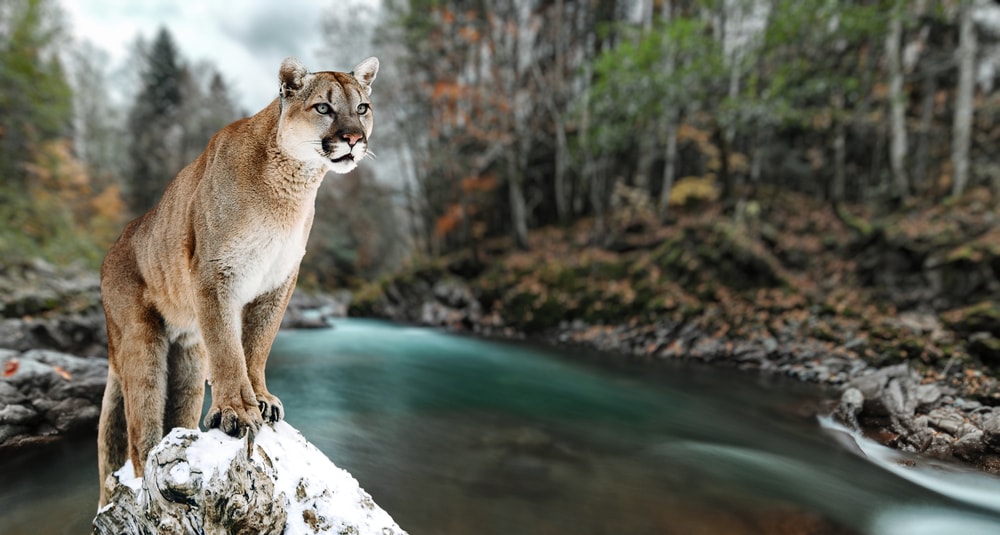
In the American West, cougars in Washington state have been an iconic species for over 1,000 decades. In fact, they’re the biggest members of Washington’s cat family.
Washington’s cougar population is approximately 17 cougars per 1000 sq. km (386 sq. m). This accounts for around 1,500 animals. According to the Washington Department of Fish and Wildlife (WDFW), these numbers are declining. Care to know why? Read on!
Habitat & Range
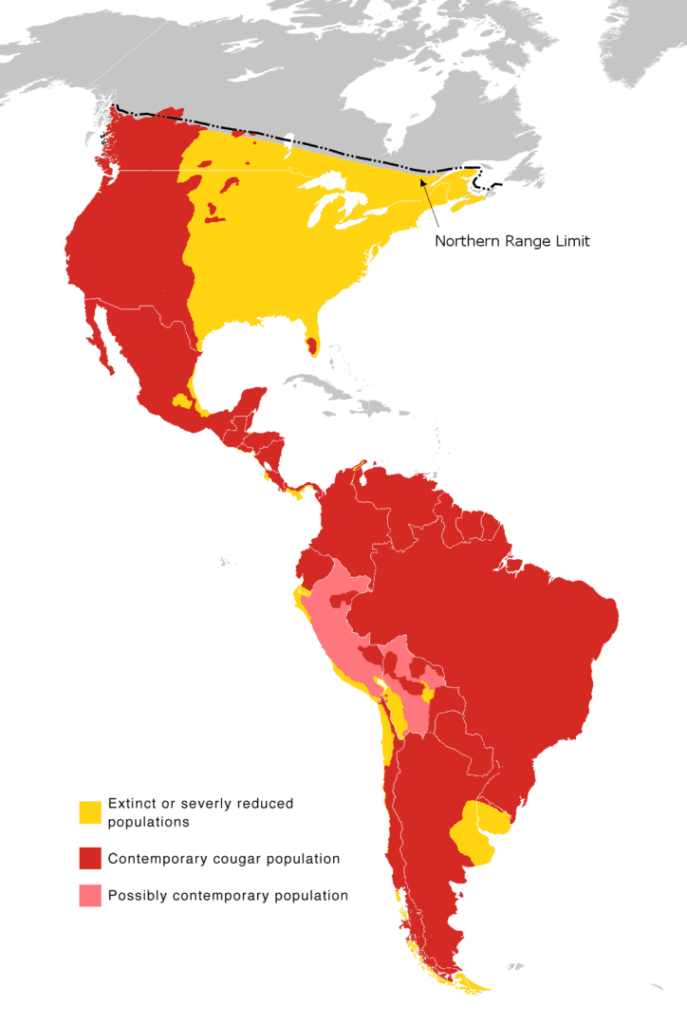
By Kokosdieb – Own work / CC BY-SA 3.0 / Wikimedia commons h
Cougars inhabit regions with adequate prey and cover to stay out of sight while hunting. You can find them in rock outcroppings, forests, and steep canyons.
Cougars are everywhere in the state except the islands of Puget Sound and the Columbia Basin. The WDFW states that approximately 46% of the land area is cougar habitat.
Depending on the terrain type, time of year, availability of prey, and age, adult male cougars roam a wide area. They cover an area of 50 to 150 square miles (129.5 to 388.5 square kilometers).
This range typically overlays the home range of three or four females. The range of females is roughly 50% less than their male counterparts. Female ranges typically overlap significantly with other females.
Like house cats, cougars leave claw marks on stumps and trees to mark their territory. The claw marks average 6 feet (1.8m) above the ground. They’re made up of deep, long, parallel lines that run vertically.
Physical Appearance
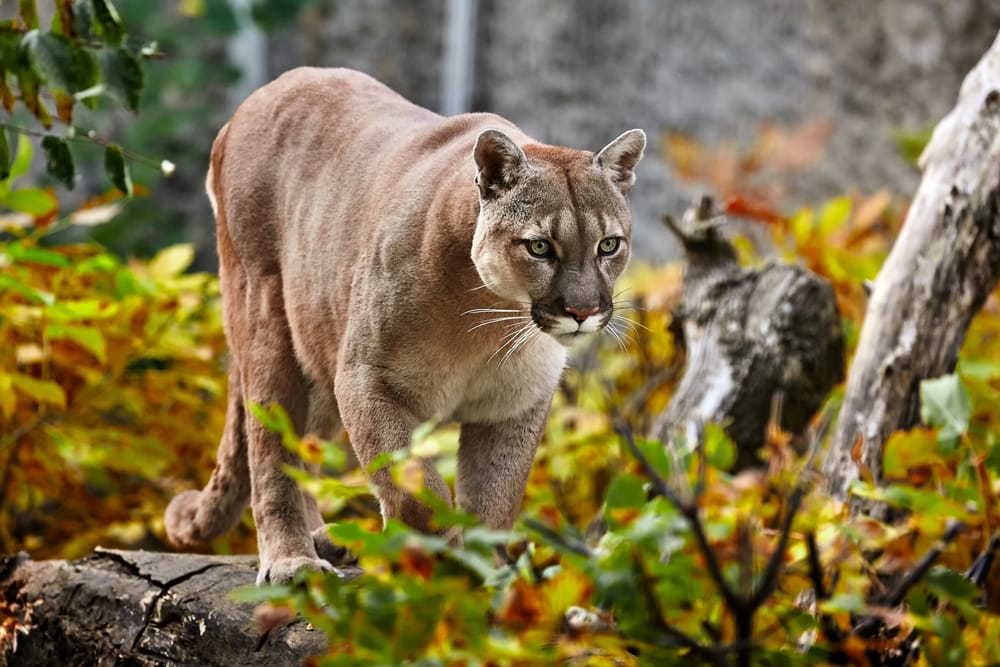
A cougar can also be known as a mountain lion, panther, puma, and catamount, to name a few. Their scientific name is Puma concolor.
They vary in color, ranging from reddish-brown to tawny (a mix of yellow, orange, and brown) to gray. Their chest and muzzle areas are primarily white. The tips of their long tail, ears, and face have black markings.
An adult cougar’s length varies from 42 inches (106cm) in females to 54 inches (137cm) in males. Their tail length is approximately 36 inches (91cm).
They can weigh between 120 pounds (54kg) for females to 200 pounds (90kg) for males. Cubs are spotted with ringed tails, which they keep for roughly six months.
Adult females stand almost 25 inches (63.5cm) tall at the shoulder. The adult male cougars average roughly 25% bigger than females. The tips of their long tail, ears, and face have black markings.
Like all other cat species, cougars possess four digits on the hind paws. They also have five on the front, each equipped with a claw. These claws remain sheathed until it is time to take down prey.
The forepaws are more significant than the hind paws. As cougars walk, they leave behind soft tracks.
The powerful jaws of the cougar permit them to take down prey larger than itself and drag it to a safe spot to devour it.
Lifecycle & Reproduction of Cougars
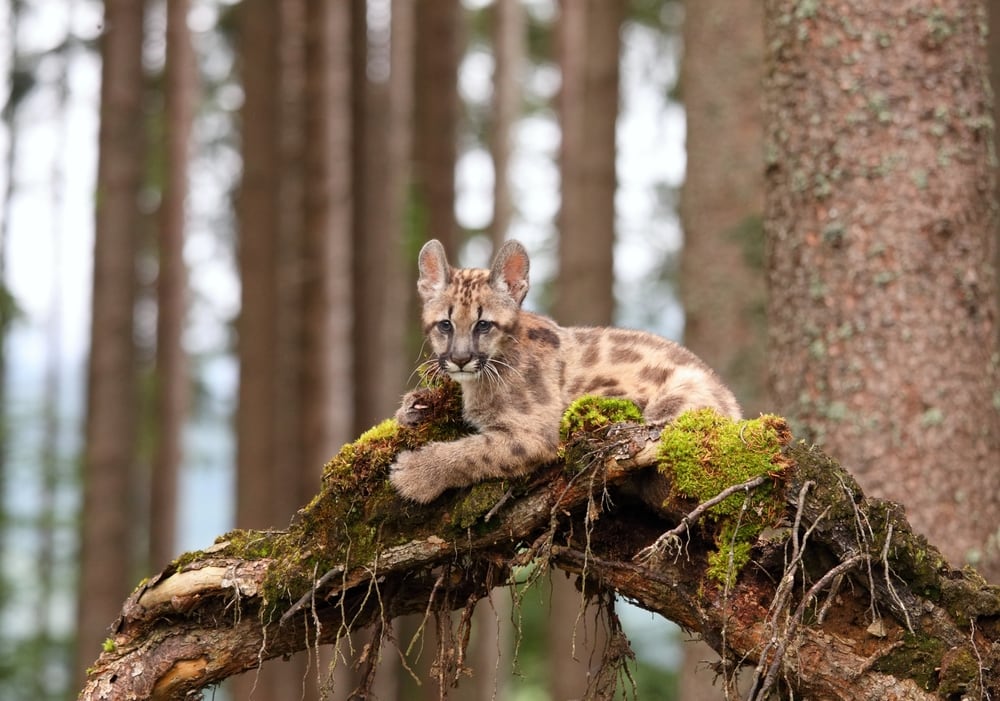
Male cougars live between 10 to 12 years in the wild, while females live longer than males.
Cougars take between three to five years to reach full maturity. They start being sexually active at around three years old.
Mating could occur during any season, meaning cougars may be born anytime during the year. Female cougars have litters averaging three or four cubs after a gestation period of between 82 to 98 days. Females can give birth every two to three years.
Adolescent cubs stay with their mothers until they are two years old and old enough to hunt on their own.
Adult males play no role in raising their young. Furthermore, they might attack and kill any male juveniles they come across.
Food & Feeding Habits
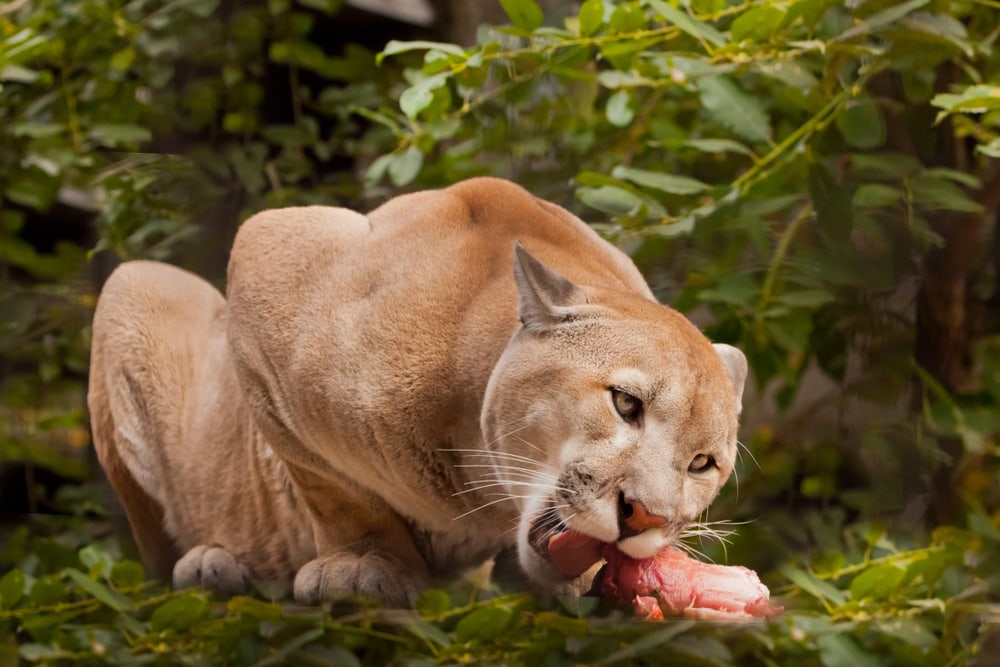
It isn’t surprising to spot a cougar hunting at any time of day, but their most active time is between dusk to dawn.
Cougars are obligate carnivores, meaning they must eat meat to survive. The adults’ preferred prey is deer, but they also hunt wild sheep, moose, elk, and mountain goats.
Adolescent cougars hunt other species, such as the following:
- Hares
- Coyotes
- Small rodents
- Rabbits
- Striped skunks
- Porcupines
- Raccoons
- Birds
- Fish
- Snails
They attack livestock and pets like chickens, goats, pigs, and sheep.
After a meal, cougars cover the leftovers with debris such as soil, leaves, or snow. Cougars stay close to their kill for eight days. They guard it against scavengers and return to eat it when hungry.
Adult cougars can consume as much as 20 pounds (9kg) of meat in one sitting.
Only females with young do not hunt alone. All others roam between locations frequented by their prey. They can wander as much as 15 miles (24km) in one night.
Cougars might stalk their prey for an hour or more. They often depend on short bursts of speed to ambush the animal.
Cougar Encounters With Humans
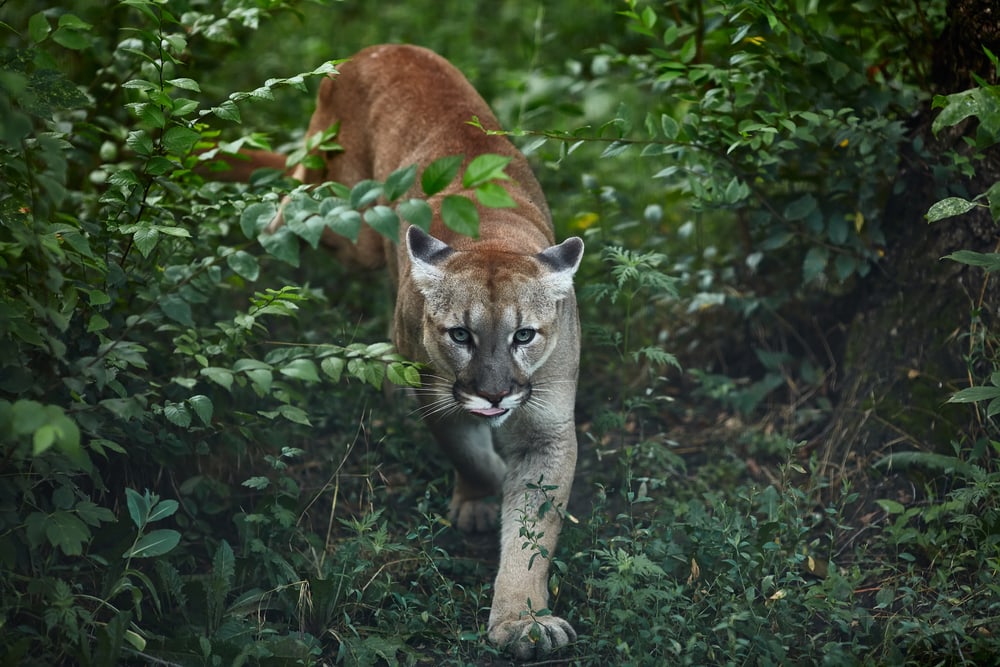
Washington has a very substantial human population. Practically 50% of the residents reside in cougar habitat. Even with this, the cougars’ elusive nature accounts for them being rarely seen in the wild.
1924 was the first documented year of a cougar attack on a human. Subsequently, authorities recorded 20 encounters between cougars and humans, resulting in injury. This period included a fatality in 2018.
The CEO of the Mountain Lion Foundation, Debra Chase, states that cougars are afraid of humans. She also stated that they do not typically see us as prey.
However, humans confuse cougars with quick movements like bicycling or running. These movements make humans resemble food in the cougars’ eyes. This confusion results in attacks on humans.
Due to their lack of speed and size, children are more vulnerable to these attacks. Nonetheless, attacks on humans are still rare.
Encountering Cougars
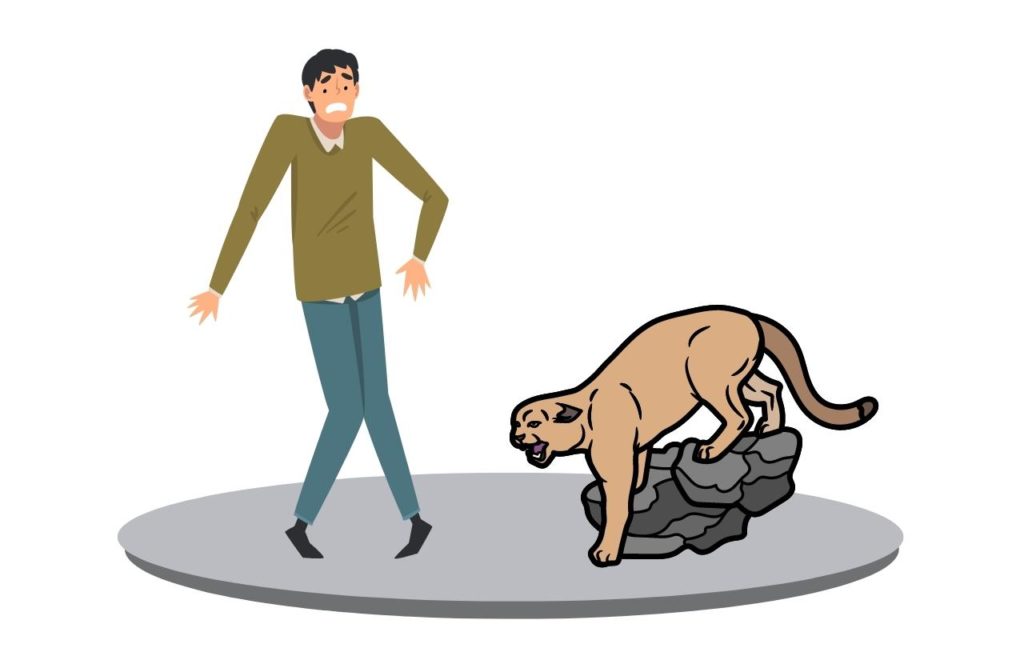
If you encounter a cougar, your actions can hinder or help with a speedy retreat. Below are a few measures to be taken if this occurs:
You may also like: Do Coyotes Attack Humans? Exploring Our Relationship With Coytes & Tips For Coexisting Safely
Predators of Cougars
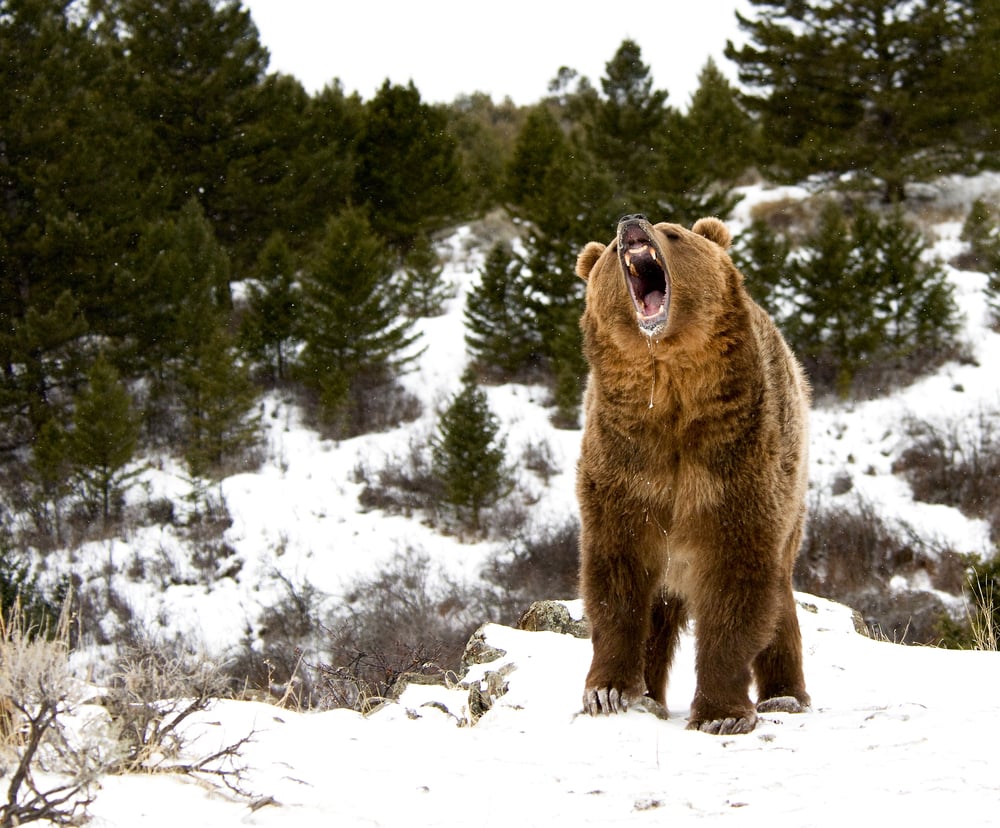
Generally, cougars are apex predators and sit on top of the food chain. Cougars are not threatened through predation as they have no natural enemies.
With that said, they periodically compete for food with other predators. Gray wolves and grizzly bears are their common competitors.
The diets of cougars and grizzly bears are very similar to each other. This leads to them competing for the same food source.
A study between bears and cougars was published in the journal “Ursa.” Accordingly, bears displaced cougars from their kills as much as 26% of the time.
Another similar study was published in “Ecoscience.” It found that cougars were susceptible to wolf attacks during competition. As cougars are stronger than wolves, wolves tend to attack as a pack.
You may also like: The 7 Types Of Big Cats Around The World And Where You’ll Find Them
Cougar Management History In Washington
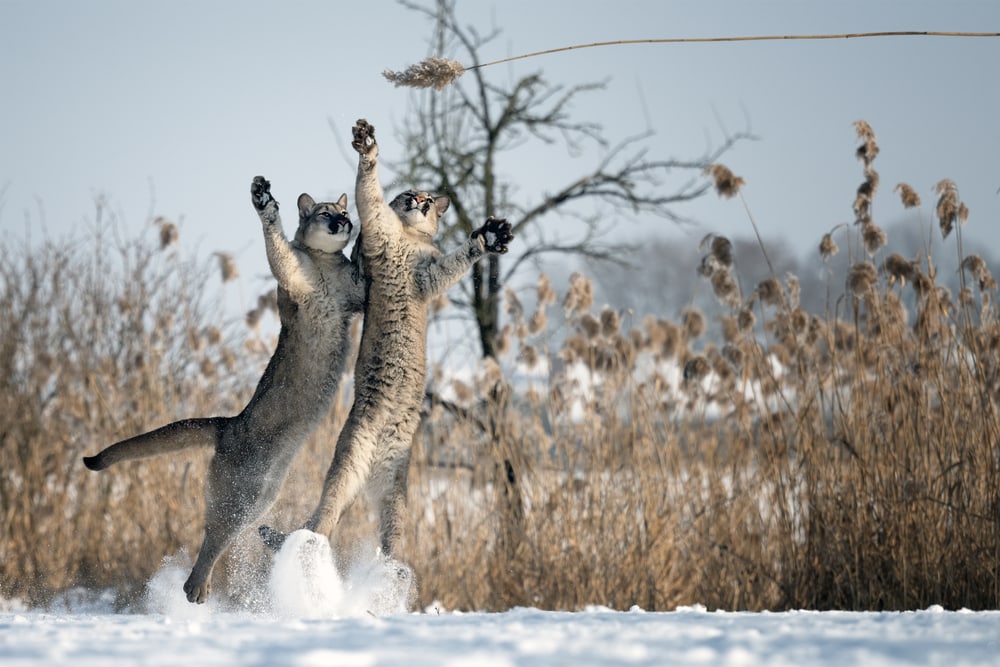
The Washington Game Department was created in 1933. Before its creation, counties promoted cougar bounty programs, which were short-lived. No one can confirm the success of the programs or how many cougars died in that period.
In 1933, cougars were categorized as predators. The state placed bounties on them two years later. This bounty lasted for 25 years until 1960 and paid for 3,064 cougars.
Moreover, cougar killing wasn’t maintainable. For the program’s last year, the number of dead cougars declined to 55.
Unregulated Hunting
Once the bounty program was discontinued, no bounty was paid for cougars. However, cougars were still categorized as predators, and no restrictions were in place.
Reports of over 380 cougars were documented. But this is not an accurate representation as reporting was spotty.
Recreational Hunting
In 1966, the Washington Game Commission categorized cougars as “game animals.” At least 8,500 cougars have been hunted and killed for recreation since 1966.
The primary strategy for hunting cougars in Washington involved hunting hounds. These hounds would track, chase, and corner cougars.
Initiative 655 banned using hounds to hunt cougars and other wildlife. However, opportunistic killing became the primary method. This measure meant hunters would depend on kills while hunting other prey, such as elk and deer.
Cougar Hunting Regulations
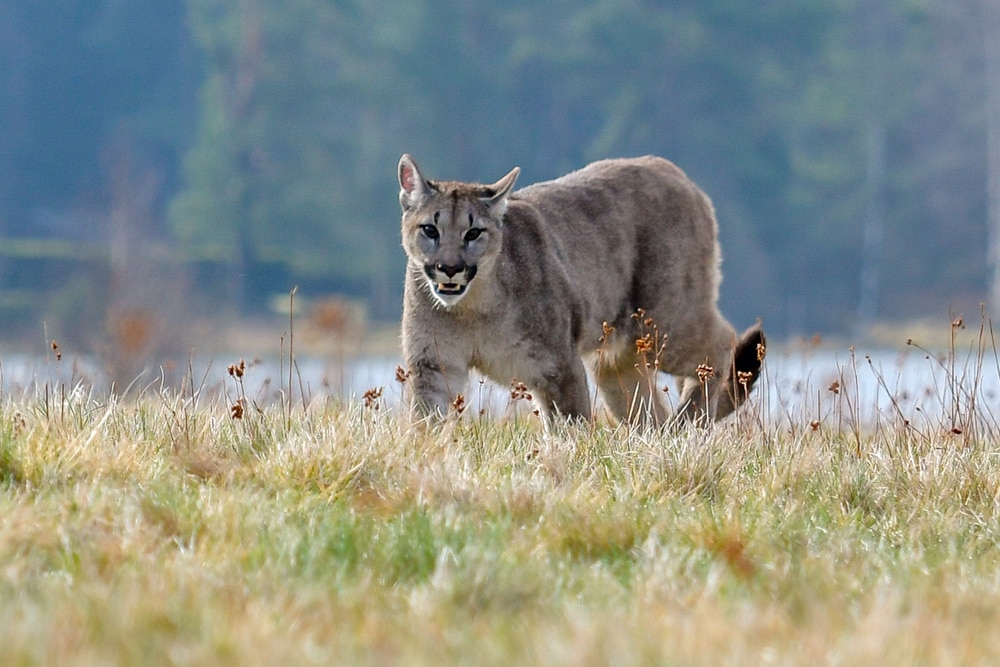
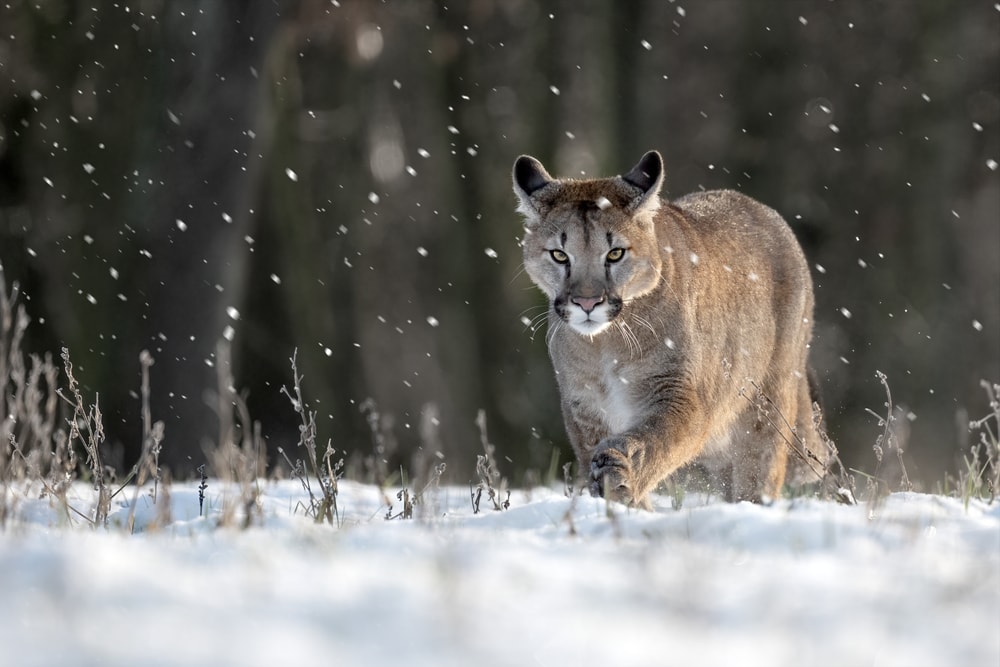
The season for hunting cougars lasts two periods. The early season begins from September 1 to December 31. The late season starts on January 1 and until April 30. Legally killing cougars requires big-game licenses.
It is each hunter’s responsibility to confirm whether the season is open or closed. The cougar hotline receives reports of all kills within 72 hours of each kill. The WDFW staff must then seal the kill (unfrozen, with proof of gender) within five days.
According to the WDFW, a property owner, their immediate family, tenant, or employee can gun down a cougar on that property. This is only allowed if it is attacking domestic animals. No permit or license is required to do this.
Cougars killed in defense of oneself or others should be justified and reasonable. The cougar’s body must be turned over to the WDFW, as it is the state’s property.
Bag Limits
The bag limit stands at one cougar per licensed year. Possessing or killing cubs or adult cougars accompanied by cubs is illegal.
You may also like: Jaguar Vs Leopard: What’s The Difference Between These Big Cats?
Threats To Cougar Population & Habitat
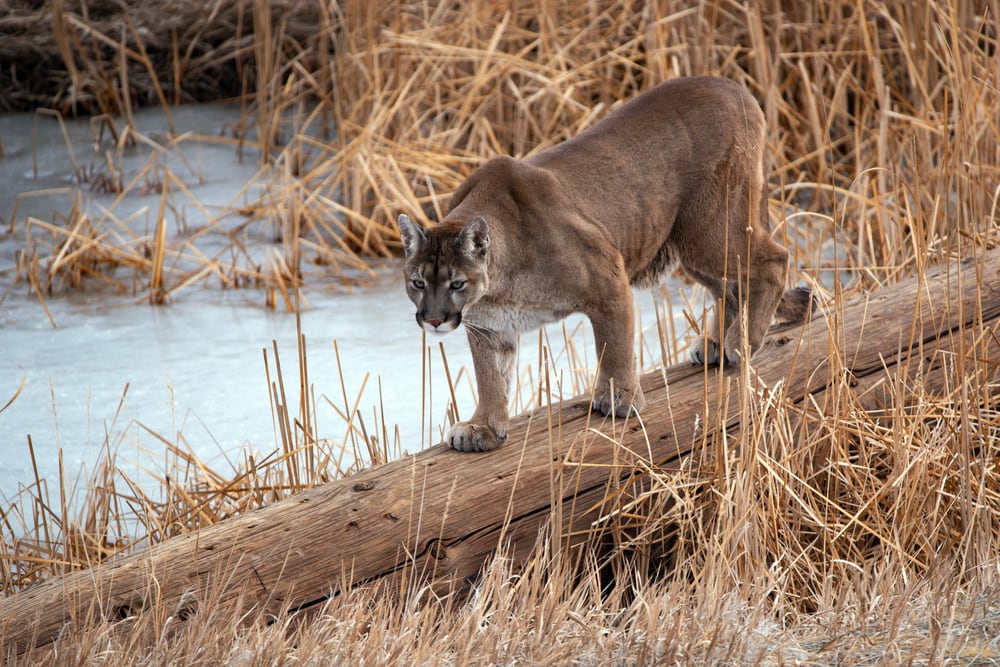
Researchers agree that overhunting and habitat loss are primary threats to cougar populations.
Killing cougars increases conflict, which increases the occurrence of killings. Cougars experience the stress of hunting and increased human activity in remote areas. Inequalities from the loss of mature cougars in established regions also stresses them.
Adult cougars have no choice but to travel further to find a suitable mate. Young, immature cougars tend to replace the more established adults. This leads to cubs being robbed of a mother before being fully trained.
Habitat Loss
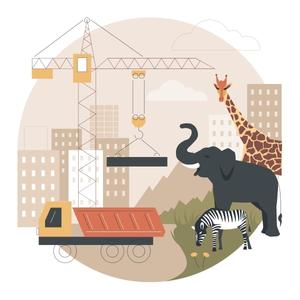
Habitat loss and fragmentation through urbanization and highway construction increase cougar encounters.
Building communities in their hunting range drives them away. When separated from prey, cougars are forced to feed on livestock and pets.
Many cougars currently reside on the Olympic Peninsula. They are bounded by Route 12 in the south and Interstate 5 in the west. This cuts them off from natural mating partners located in the Cascade Mountains.
Climate Change

Due to drought, prey availability is reduced, and wildfires destroy the cougars’ habitat. This phenomenon drives them to wander greater distances in the hunt for food.
You may also like: What Is Poaching And Why Is It Practiced?
Cougars’ Role In The Ecosystem
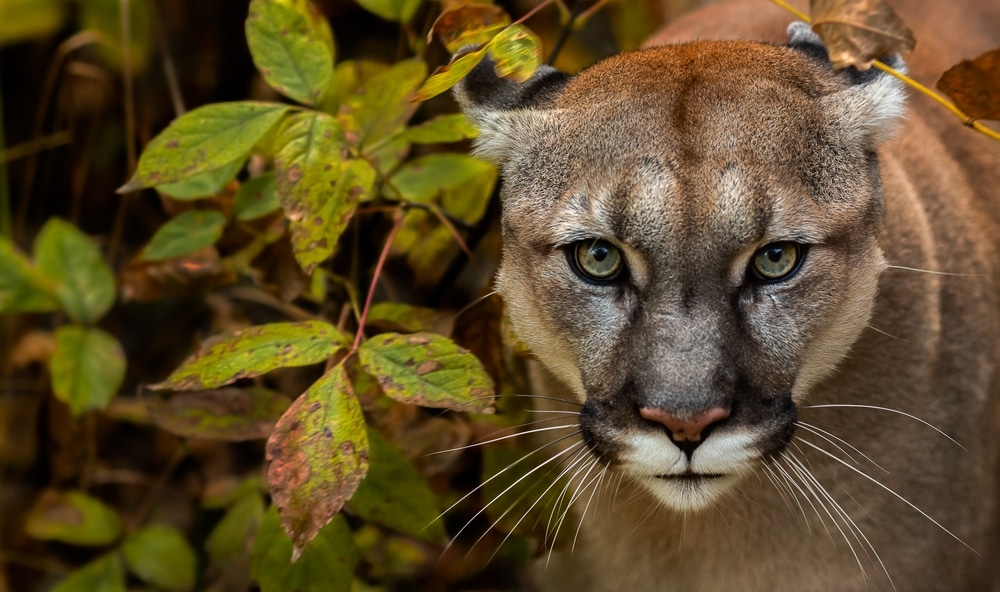
Cougars are essential to the balance of life in the regions they inhabit. As apex predators, they keep prey populations from getting out of control.
Most of the cougars’ prey are herbivores. With reduced herbivore numbers, forests can flourish and be protected from overgrazing.
Overgrazing results in several environmental concerns when removing apex predators like cougars. When woody trees and grasses are extremely reduced, it might lead to erosion of the forest floor.
The disappearance of cougars could also increase coyotes, rodents, and fewer house cats. After a cougar kills large prey, it leaves unfinished carcasses. These leftovers provide for various animals, such as bears, eagles, and beetles.
You may also like: 10 Keystone Species Examples And The Important Role They Play In Every Ecosystem
Cougar Cultural References
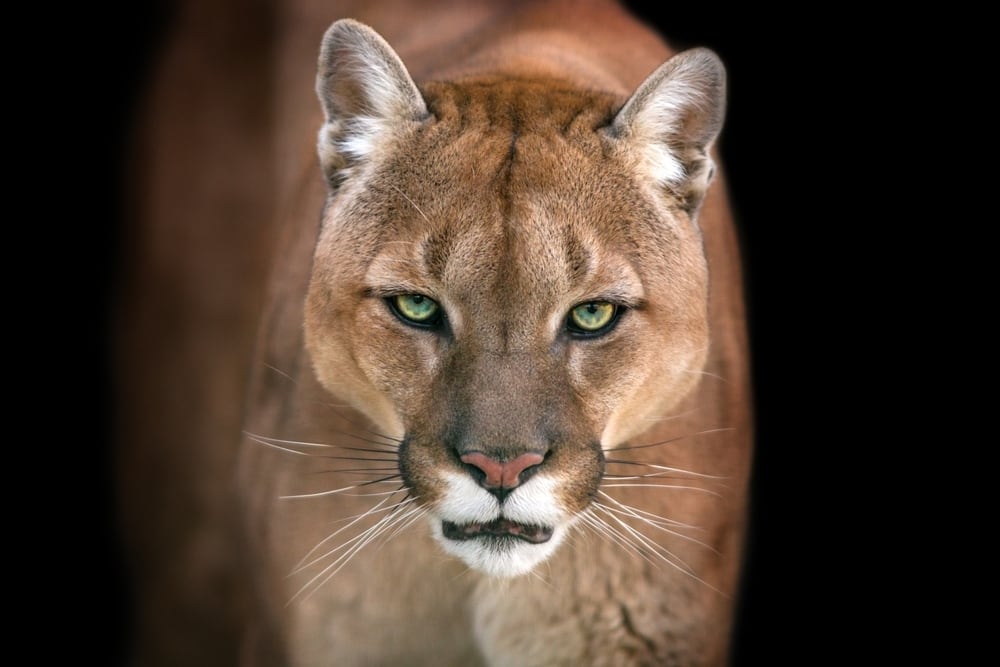
Some Native American tribes view cougars as unfavorable and others as positive.
The Apache tribe believes it is an evil omen whenever they hear the sound of the cougar. It resembles death and associates the sound with witchcraft.
The Shawnee and Seminole tribes view the cougar as a powerful medicine animal. They also believe it brings good luck during hunting. So much so that they wore parts of the animal, such as the fur, during spiritual ceremonies.
The Shoshone People view the cougar as a sacred animal that should never be hunted. Legend states that during an attack on the tribe, the medicine man made a pact with the spirit animal. The pact swore the tribe to never hunt the cougar, as it protected them against the attacking tribe.
You may also like: Nocturnal Animals List: What Stays Awake At Night?
Cougars in Washington State FAQs
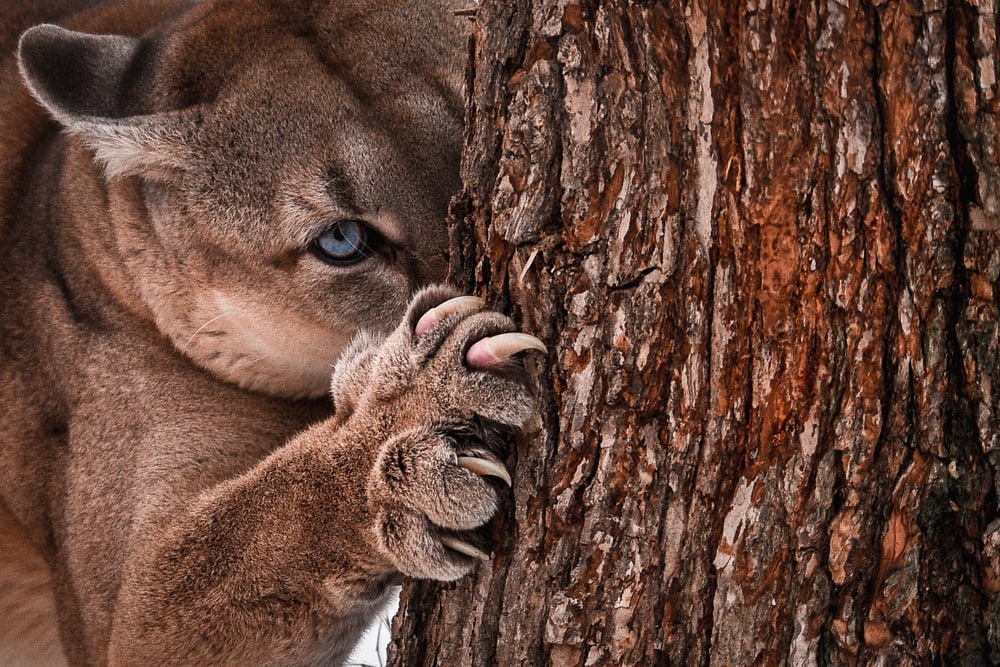
What is the difference between a cougar & mountain lion?
There is no real difference between the two cats other than the name. They are both from the same subspecies of “Puma Concolor.”
What are cougars afraid of?
According to the Mountain Lion Foundation, they fear humans the most.
When are cougars most active?
Cougars are primarily on the move between dusk to dawn but will hunt at any time of the day.
Should you look cougars in the eyes?
Always face cougars, do not let them out of your sight, but do not stare them directly into their eyes. Instead, look at their feet.
Are cougars afraid of dogs?
Dogs provide little to no value as an obstacle for cougars. However, they might distract cougars from attacking humans.
Can cougars roar?
Cougars cannot roar, but they make sounds similar to a human scream.
How high can a cougar jump?
Cougars can leap 18 feet (5.5m) vertically from a sitting position and 40 feet (12.2m) horizontally.
How many people have cougars killed in Washington?
Within the previous century, there have been two recorded fatal cougar attacks.








